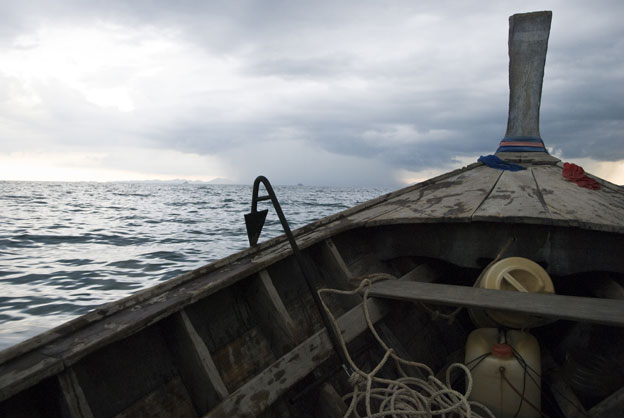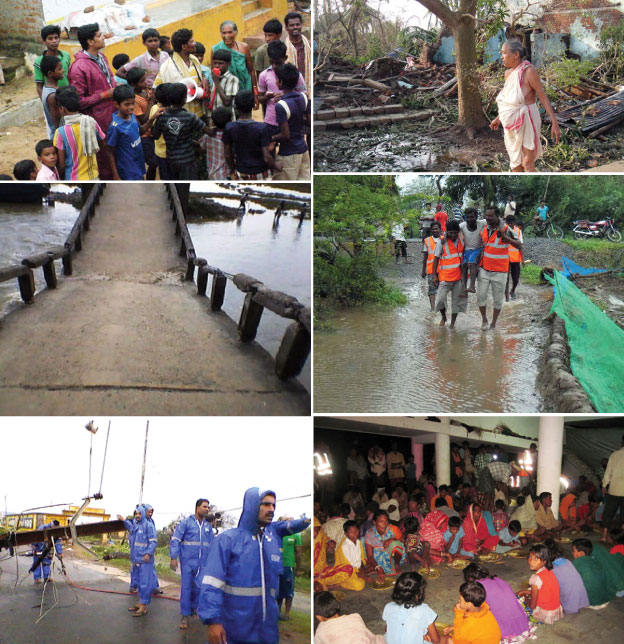SUBCONTINENT:
Triumphing Cyclone Phailin: Disaster Preparedness Saved Lives
The severe tropical cyclone, ‘Phailin,’ ploughed through the eastern shores of India, Oct. 13, and pummeled Odisha and Andhra Pradesh with winds at more than 125 mph and torrential rains, uprooting trees, ripping apart mud and thatch dwellings, breaking dykes and knocking out power lines. Thanks to a timely weather forecast and the government’s preparedness in pre-positioning measures and disaster response teams, damage to life, though not as much to property, was greatly mitigated, writes Priyanka Bhardwaj.

In 1999, when Odisha was last battered by a super cyclone, Paradwip, more than 10,000 people were killed and billions of dollars worth of property and infrastructure was damaged.
But Phailin could take about 28 lives (as per official estimates) though losses of about Rs. 9 billion were incurred by the state’s power department, and of Rs. 2.5 billion by the education department.
The worst affected districts due to floods were Balasore, Mayurbhanj, Jajpur, Keonjhar and Bhadrak while districts of Ganjam, Puri, Gajapati, Khurda were the worst hit by the cyclone.
Latest updates as furnished by government officials at Odihsa Bhawan in New Delhi reveal thousands stranded, still struggling to get back to their ravaged villages and towns to start life anew with their destroyed homes, fields, and assets that could not be saved.
In Balasore, as per a volunteer (wishing for anonymity) of a non-government organization, the numbers of worst affected people could be seven times higher than official estimates, that is pegged at a hundred thousand.
In a telephonic interview, Balasore Revenue Divisional Commissioner, Arabinda Kumar Padhee, recounted how the initial resistances of people in paying heed to warnings sent out by the government posed challenges to the authorities in bringing matters under control.
Additional Secretary of Odisha, Dasaratha Satapathy, added that more than a thousand free-meal-kitchens of the schools were pressed into service with help of teachers to cook food for distribution among the poor and evacuees.
This was the first occasion in history when the state government, run by Naveen Patnaik’s Biju Janata Dal, was successful in taking disaster management steps on such a large scale.
Patnaik personally reviewed the situation and saw to it that the services of the army, National Disaster Response Force, Odisha Disaster Response Force and the state police were incorporated in relief operations in the affected areas while the defense forces were put on standby.

(Above): (Clockwise from top left): Task force members persuading the villagers to evacuate; destroyed households in cyclone Phailin; shelter task force members evacuating a disabled person to Koithakala shelter in Bhadrak district; cooked food served to the people in the shelters; ODRAF in action removing damaged electric poles; and a damaged bridge to Garasahi Baliapal MPFS in Balikuda GP of Balasore district in Odisha. [Photos: Odisha State Disaster Management Authority]
With the lives of 1.2 millions living on the coastal areas at stake, evacuation process, sometimes forcibly, and early warnings to fishermen was started five days in advance, trains and flights were canceled and helicopters, boats, ferries and other transport means kept ready for any eventuality.
For a country that has been at the receiving end for lack of preparation and apathy for loss of lives in aftermath of any natural disaster, the officials’ efforts have been credibly appreciated by organizations like the World Bank.
A World Bank statement reads, “Successfully evacuating a million people is not a small task. This cannot be merely achieved by kicking the entire state machinery into top gear for three-four days following a cyclone warning… this has taken years of planning, construction of disaster risk mitigation infrastructure, setting up of evacuation protocols, identification of potential safe buildings, increasing shelter homes and most importantly, working with communities and local organizations in setting up volunteer teams who all knew exactly what needed to be done.”
A special mention has been made of the Odisha State Disaster Management Authority and Government of Odisha for their commendable work in increasing number of multi-purpose cyclone shelters, evacuation routes and strengthening of coastal embankments and conducting mock drills in coastal districts and inducting community effort at all stages and levels in the bank’s statement.
The World Bank has been closely associated with the regions of the two states evident from the fact that in March 2011 it had embarked on its first ‘ex-ante’ disaster risk management project focused on poor to gear towards better preparedness to a natural disaster or to tackle negatives of climate change in coming times.
Also, it had invested $225 million for improvement of early warning systems while also funding National Cyclone Risk Mitigation Project under implementation in both states.
Tom Mitchell, heading climate change at London-based Overseas Development Institute too has lavished praise on authorities’ preparedness saying, “Credit is due to those who have been involved in efforts to reduce the scale of vulnerability to disasters across India. The low loss of life, following the strongest storm ever measured in Bay of Bengal, would almost certainly not have been possible without learning lessons from previous cyclones and tsunamis that have hit this coastline.”
But conversations with authorities, working at ground level show that gaining this achievement was not easy.
Officials working at micro-levels like Ganjam collector Krishan Kumar had to personally supervise his team’s operations, risking life at times for which he has been well applauded by the government.
Kumar says, “Our aim was to keep casualties to a minimum. Hence, we did everything we could to evacuate people close to the coast. There was stiff resistance from the people at first but they gave in finally to being evacuated. We started preparations from Wednesday (October 8) as soon as we got warning of the impending calamity. From identifying the vulnerable areas to designating 1,060 government buildings as cyclone shelters and readying plans for post-disaster relief and restoration efforts, we did everything in quick time.”
Interestingly, both London-based Tropical Storm and the U.S. Navy’s Joint Typhoon Warning Center classified Phailin as a Category 5 storm - the most powerful category in which Hurricane Katrina was also classed – and much more severe than was pre-assessed by Indian Meteorological Department.
The preparedness was well planned but there is still room for improvement as eyewitnesses say that many poor people had to live off meager and poor quality flattened rice and seek refuge in inadequately run designated shelters, few in number and lacking in basic amenities.
There were also hundreds of farmers, like Sukanti Kar’s family of eight, who had to spend the eventful night on the highway and depend on food handed out by passers-by in vehicles.
Such stories could be the reason why mass demonstrations were witnessed on highways in districts of Khurda and Mayurbhanj and their grievances were given voice by various opposition political parties like Bijoy Mohapatra of the Bharatiya Janata Party who protested against this neglect of these regions.
In this sad state of affairs, there is some heartening news for the fishermen and fish consumers as ocean experts at the Indian National Center for Ocean Information Services say that the churning and surfacing of nutrient rich deep waters due to the cyclone might result in larger quantities of fish and possible reduction in its market price.
Also with the cyclone having hindered the retreat of monsoon, the North and North Western states of the country are expected to enjoy prolonged spell of pleasant daytime temperatures.
Coming back to Pahilin and the states it visited, both Odisha and Andhra Pradesh with their well-equipped and exclusive disaster management departments, cyclone shelters and help coming from international humanitarian organizations like the Indian Red Cross that deployed its volunteers for aid and evacuation purposes proved lucky and successful this one time.
An expert geologist, Sudipta Sengupta, says that with at least 76 percent of the country’s coastline exposed to frequent cyclones and tsunamis, 59 percent of India prone to earthquakes, 10 percent to floods and river erosion, and 68 percent to droughts, sagacity lies in heeding to threats of environmental disasters and our constant efforts to mitigate climate change while investing well in better planning and effective implementation of these plans in taking on these threats.
|